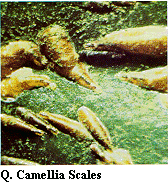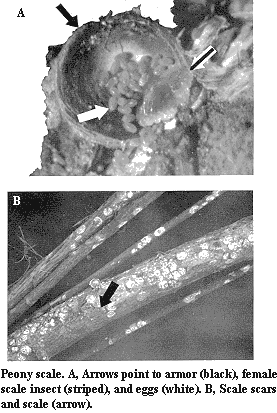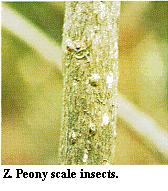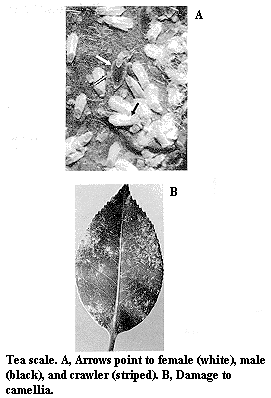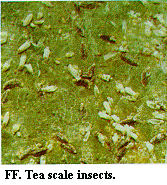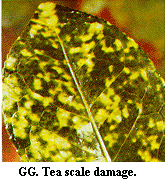Key to Camellia Pests
Camellia are prominent flowering shrubs in the Piedmont and Coastal Plain. Approximately 2,000,000 camellia plants are grown in Southern greenhouses and nurseries each year. Three species of camellia are in general cultivation: Camellia japonica, C. sasanqua, and C. reticulata. Varieties of these species flower in red, pink, or white, or combinations of these colors. Though numerous species of insects and mites have been reported on Camellia few actually cause damage; the vast majority are merely casual visitors. Scale insects are the most serious pests of the camellia.
- Camellia scale – Most prevalent on cuttings and young plants grown in greenhouses, the camellia scale infests only leaves. The foliage appears sickly but not discolored; it can drop prematurely. The armor of the female scale resembles a tiny oyster shell.
- Peony scale – Appearing white and circular on bark, the peony scale can kill twigs and branches, if infestation is severe. The convex shell of the scale, being small and brown, is an inconspicuous hump on the bark.
- Tea scale – On the upper surface of infested leaves are yellow splotches caused by the feeding of the underlying insects; cottony masses are evident on the undersides of the leaves. Plant vigor and production of blooms may be impaired.
Camellia Scale
Camellia scale, Lepidosaphes camelliae Hoke, Diaspididae, HEMIPTERA
DESCRIPTION
Adult – The shell of the female camellia scale varies from light to dark brown and resembles an oyster shell. Nearly 2.5 mm in length, it covers the white to purplish saclike insect.
Nymph – The immature male scale lives under a smaller shell narrower than that of the adult female (Figure Q). Immature females secrete an oval armor about 0.8 mm long.
BIOLOGY
Distribution – Wherever camellias are grown, the camellia scale is a pest.
Host Plants – Unlike the tea scale, the camellia scale has little effect on camellias grown under natural conditions. It is found mostly on cuttings and on young plants in greenhouses and nurseries. The camellia scale is found on Camellia spp. and holly (flex spp.).
Damage – The devitalized foliage drops prematurely but is not discolored. The sale value of infested plants is reduced.
Life History – When 40 to 50 days old, females lay 25 to 55 eggs, which hatch in 11 to 24 days. From the shell, the young nymphs (crawlers) migrate either to fresh leaves or to old leaves near the parent. As soon as they settle, they begin to secrete a protective covering. In 12 to 17 days after birth, they molt. The second molt occurs 6 to 10 days later, after which the shell gradually enlarges to accommodate the growing insect. The life cycle is usually completed in 60 to 70 days. Few eggs are laid outdoors during the winter, but hatching may continue in greenhouses and in cold frames. Because of overlapping broods, all stages of the life cycle are present in summer.
CONTROL
The camellia scale is often heavily parasitized by tiny wasps, which make holes in the shells when they emerge. Lady beetles also feed rather extensively on this scale. For specific chemical controls, see the current state extension recommendations.
Peony Scale
Peony scale, Pseudaonidia paeoniae (Cockerell), Diaspididae, HEMIPTERA
DESCRIPTION
Adult – With a small, grayish-brown shell, the adult grows to about 2.5 mm. The female is circular or oval, and moderately to very convex (Figure Z). The orange yellow exuviae are subcentral to submarginal. Though similar to the female, the immature male is more slender, with submarginal exuviae.
Nymph – The nymph is tiny, flat, and purple.
BIOLOGY
Distribution – The peony scale has been reported only in the South.
Host Plants – Found mostly on camellias and azaleas, the peony scale is occasionally present on ligustrum and other shrubs.
Damage – Burrowing beneath the bark of twigs and stems, the scale feeds on plant juices. Infested areas swell and later sink; small stems die quickly.
Life History – Little information on the biology and control of the peony scale is available. The scale has a burrowing habit, at times becoming practically hidden by the bark. Its presence, in such cases, can be detected only by the discovery of small bumps on the bark. Crawlers are present in May, only one generation of young being produced per season.
CONTROL
The scale is sometimes parasitized by a small wasp. For specific chemical controls, see the current state extension recommendations.
Tea Scale
Tea scale, Fiorinia theae Green, Diaspididae, HEMIPTERA
DESCRIPTION
Adult – The female tea scale is at first thin and light yellow, later becoming hard and brown. Elongate oval or boat shaped, it is 1.5 mm long, with the residue from the first molt attached at one end. The male adult is soft, white, and narrow with a ridge down the middle of its back (Figure FF).
Egg – The egg is yellow and lemon shaped.
Nymph – The nymph is a flat, yellow "crawler."
BIOLOGY
Distribution – The tea scale has been reported on camellias in the South and in California.
Host Plants – In the Southeast, the tea scale is a serious pest of camellias as well as Chinese and Japanese hollies. It has also been reported on bottlebrush, dogwood, euonymus, ferns, mango, Satsuma orange, orchids, tea plant, and yaupon.
Damage – The infestation occurs primarily on the undersides of leaves. The most conspicuous characteristic of an infested plant is yellow splotching on the upper leaf surfaces, an effect of feeding insects underneath (Figure GG). The whole plant may appear generally unhealthy, with leaves dropping prematurely. The number of blooms decreases, and cuttings may die before roots develop.
Life History – Each female deposits from 10 to 15 eggs under the scale shell. They hatch in 7 to 21 days, depending on the weather. The flat, yellow crawlers migrate to the newer growth on the plant and, in 2 or 3 days, attach themselves. At first they secrete thin, white coverings, but shortly afterward they produce great quantities of white threads. When the population of nymphs is dense, the undersides of the leaves may be covered with this cottony secretion. The nymphs molt 18 to 36 days after hatching, and a second molting occurs about a week later. From 41 to 65 days after hatching, female scales begin to lay eggs. The life cycle is usually completed in 60 to 70 days. The hatching of tea scale nymphs occurs throughout the year, although it is less frequent in cold than in warm weather. Because there are many overlapping broods, crawlers can hatch continuously from March to November.
CONTROL
Several spray mixtures are recommended for the control of tea scale. These sprays should be heavily applied to the undersides of leaves. The best time to spray is in the spring, after the plants have finished blooming and the danger of cold weather has passed. Two applications, 10 days apart, should be sufficient. For specific chemical controls, see the current state extension recommendations.
Publication date: Jan. 1, 1993
AG-189
Other Publications in Insect and Related Pests of Shrubs
N.C. Cooperative Extension prohibits discrimination and harassment regardless of age, color, disability, family and marital status, gender identity, national origin, political beliefs, race, religion, sex (including pregnancy), sexual orientation and veteran status.


